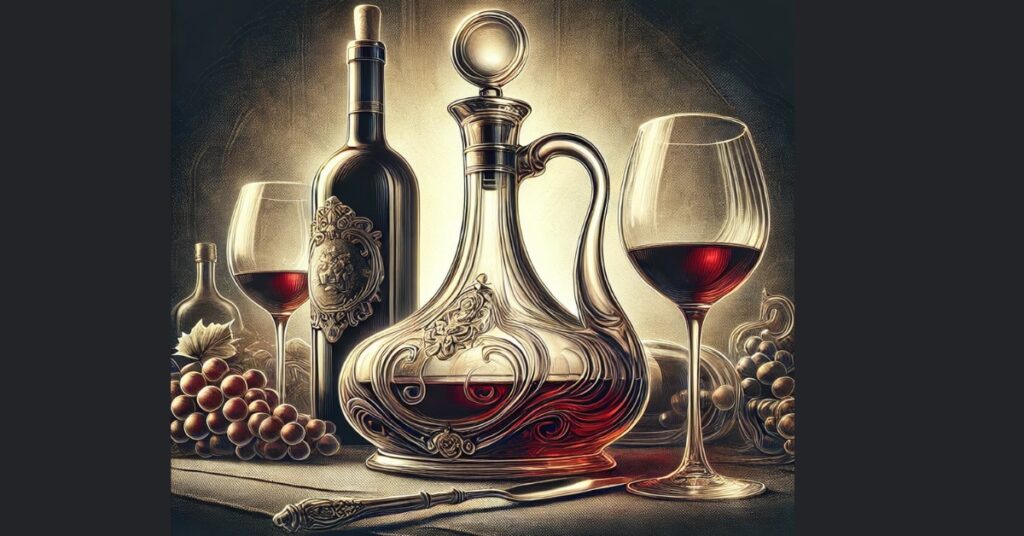Decanters have been an essential part of the wine-drinking experience for centuries. These vessels, often made of glass or crystal, are designed to enhance the flavor and presentation of wine, as well as other beverages. The act of decanting—pouring liquid from one vessel into another—has both practical and aesthetic purposes. In this comprehensive guide, we’ll explore the history, types, and uses of decanters, the benefits of decanting, and how to choose the perfect decanter set for your needs.
The History of Decanters
The use of decanters dates back to ancient civilizations, where they were used to store and serve wine. The Romans were among the first to use glass decanters, which were prized for their clarity and beauty. Over the centuries, the design of decanters evolved, with artisans creating more elaborate and ornate vessels. By the 18th century, decanters had become a symbol of refinement and luxury, often found in the homes of the wealthy.
What is a Decanter?
A decanter is a vessel used to decant or to receive decanted liquids, especially an ornamental glass bottle used for serving wine. The process of decanting involves pouring wine or another liquid from its original bottle into the decanter, allowing it to breathe and separate from any sediment that may have formed. Decanters come in various shapes and sizes, with the most common being made of glass or crystal. The primary purpose of a decanter is to enhance the flavor and aroma of the wine, but it also serves an aesthetic function, making the presentation of the wine more elegant.
The Purpose and Benefits of Decanting
1. Aeration
One of the main reasons for decanting wine is to aerate it. When wine is poured into a decanter, it comes into contact with air, allowing it to breathe. This process helps to release the wine’s aromas and flavors, making it more enjoyable to drink. Aeration is particularly beneficial for red wines, which often have complex flavors that need time to develop. Decanting can also help to soften tannins, making the wine smoother and more balanced.
2. Sediment Separation
Another important function of decanting is to separate the wine from any sediment that may have formed in the bottle. Sediment is more common in older wines and can give the wine a bitter or gritty taste if consumed. By decanting the wine, you can leave the sediment behind in the bottle, ensuring that only the clear, flavorful liquid is poured into the decanter.
3. Presentation
Decanting also enhances the presentation of the wine. A beautifully crafted decanter can be a stunning centerpiece on the dining table, adding a touch of elegance to any meal. Whether you’re hosting a dinner party or enjoying a quiet evening at home, serving wine from a decanter can elevate the experience.
Types of Decanters
Decanters come in a variety of shapes, sizes, and materials, each designed to suit different types of wines and beverages. Here are some of the most common types of decanters:
1. Standard Wine Decanter
The standard wine decanter is typically made of glass or crystal and has a wide base with a narrow neck. The wide base allows for maximum surface area exposure to air, aiding in the aeration process. This type of decanter is suitable for most red wines and some white wines.
2. Aerating Decanter
An aerating decanter is designed to speed up the aeration process. These decanters often have unique shapes or built-in aeration systems that help to oxygenate the wine more quickly. Aerating decanters are ideal for those who want to enjoy their wine immediately after opening.
3. Crystal Decanter
Crystal decanters are often more ornate and luxurious than standard glass decanters. They are made from high-quality crystal, which is known for its clarity and brilliance. Crystal decanters are a popular choice for special occasions and make beautiful gifts for wine enthusiasts.
4. Whiskey Decanter
While decanters are most commonly associated with wine, they are also used for other spirits, such as whiskey. A whiskey decanter is typically smaller than a wine decanter’s and has a more solid, square shape. These decanters often come with a stopper to keep the whiskey fresh.
5. Water Decanter
A water decanter is similar in shape to a wine decanter but is used for serving water. These decanters are often found in restaurants and hotels, where they are used to serve water in an elegant and stylish manner. Water decanters can be made from glass, crystal, or even stainless steel.
6. Decanter Sets
Decanter sets are a popular choice for those who enjoy serving multiple types of beverages. These sets typically include a decanter and matching glasses, and they may come in various sizes, from 4 pieces to 12 pieces. A decanter set is an excellent addition to any home bar or dining room.
How to Choose the Perfect Decanter
Choosing the right decanter’s can enhance your wine-drinking experience. Here are some factors to consider when selecting a decanter:
1. Material
The material of the decanter is an important consideration. Glass decanters are more affordable and widely available, while crystal decanters are more luxurious and often more expensive. If you’re looking for a decanter that makes a statement, a crystal decanters may be the best choice.
2. Shape
The shape of the decanter affects how the wine interacts with air. Decanters with a wide base provide more surface area for the wine to breathe, making them ideal for red wines. If you’re decanting a white wine or a delicate red wine, a decanter with a narrower base may be more suitable.
3. Size
Decanters come in various sizes, from small carafes to large vessels that can hold an entire bottle of wine. Consider how much wine you typically serve when choosing a decanter. If you often entertain guests, a larger decanter may be more practical.
4. Design
The design of the decanter is also important, especially if you plan to display it on your dining table or bar. Look for a decanters that complements your décor and adds a touch of elegance to your space. There are many designs to choose from, ranging from simple and modern to ornate and traditional.
5. Stopper
Some decanters come with a stopper, which can help preserve the wine after it has been decanted. If you’re decanting wine that you plan to enjoy over several hours, a stopper can help keep it fresh. Stoppers are also useful for spirits like whiskey, which can evaporate if left uncovered.
The Art of Decanting
Decanting is more than just pouring wine from one vessel to another; it’s an art form that requires a bit of skill and knowledge. Here’s how to decant wine like a pro:
1. Choose the Right Decanter
The first step in decanting is to choose the right decanters for the wine you’re serving. As mentioned earlier, different wines benefit from different shapes and sizes of decanters. Select a decanter that suits the type of wine you’re serving and the occasion.
2. Let the Wine Breathe
Once you’ve poured the wine into the decanters, let it breathe for a while. The amount of time you should let the wine breathe depends on the type of wine. Younger, full-bodied red wines may need to breathe for an hour or more, while older wines and delicate whites may only need a few minutes.
3. Pour Slowly
When decanting wine, pour it slowly and steadily into the decanter. This helps to prevent the sediment from being disturbed and ensures that the wine is evenly aerated. If you’re decanting an older wine with a lot of sediment, you may want to use a fine-mesh strainer to catch any particles.
4. Serve with Style
Once the wine has been decanted, it’s time to serve it. Hold the decanter by the neck or the base and pour the wine into glasses, tilting the decanter slightly to control the flow. If you’re using a crystal decanter, be sure to handle it with care, as crystal can be fragile.
Caring for Your Decanter
Proper care and maintenance of your decanter are essential to ensure that it remains in good condition and continues to enhance your wine-drinking experience. Here are some tips for caring for your decanter:
1. Cleaning
Cleaning a decanter can be tricky, especially if it has a narrow neck or an intricate design. To clean your decanter, rinse it with warm water immediately after use to prevent any wine residue from drying and staining the glass. You can also use a mixture of warm water and a few drops of mild dish soap to clean the inside of the decanter. For stubborn stains, try using a decanter cleaning brush or a solution of white vinegar and water.
2. Drying
After cleaning your decanter, it’s important to dry it thoroughly to prevent water spots and streaks. To dry the decanters, use a soft, lint-free cloth or let it air dry upside down on a decanters drying stand. Avoid using abrasive materials that could scratch the glass or crystal.
3. Storage
When not in use, store your decanters in a safe place where it won’t be knocked over or damaged. If you have a crystal decanter, be sure to store it away from direct sunlight, as prolonged exposure to sunlight can cause the crystal to become cloudy. You may also want to cover the decanter with a cloth or place it in a protective case to keep it dust-free.
4. Handling
Handle your decanters with care, especially if it’s made of crystal. Crystal decanters are more delicate than glass decanters and can chip or break if dropped. When pouring wine from a crystal decanters, hold it by the neck or base and avoid gripping it too tightly.
The Role of Cork Stoppers in Decanting
Cork stoppers play a crucial role in the decanting process, particularly for spirits and other beverages that may be stored in a decanter for an extended period. Cork stoppers provide an airtight seal that helps preserve the freshness and flavor of the liquid inside the decanter. Here’s what you need to know about cork stoppers for decanters:
1. Types of Cork Stoppers
Cork stoppers come in various sizes and shapes, designed to fit different types of decanters. The most common types of cork stoppers include natural cork, agglomerated cork, and synthetic cork. Natural cork is made from the bark of cork oak trees and is prized for its elasticity and sealing properties. Agglomerated cork is made from small pieces of cork that are bonded together with adhesive, while synthetic cork is made from plastic or rubber materials.
2. Cork Stopper Sets
Cork stopper sets are a convenient option for those who own multiple decanters. These sets typically include cork stoppers in various sizes, allowing you to find the perfect fit for each of your decanters. Some sets may also include stoppers with decorative tops, adding a touch of style to your decanter.
3. Choosing the Right Cork Stopper
When choosing a cork stopper for your decanter, it’s important to consider the size and shape of the decanter’s neck. The stopper should fit snugly in the neck of the decanter, creating an airtight seal without being too tight. If the stopper is too loose, it won’t provide a proper seal, and if it’s too tight, it may be difficult to remove.
4. Caring for Cork Stoppers
Caring for cork stoppers is relatively simple. After use, wipe the stopper with a damp cloth to remove any residue. If the stopper becomes stained or develops an odor, you can soak it in a solution of water and white vinegar to clean it. Be sure to let the stopper dry completely before placing it back in the decanter.
The Importance of a Decanter Set
A decanter set is a versatile and stylish addition to any home, offering a coordinated way to serve and enjoy your favorite beverages. Here’s why a decanter set is worth considering:
1. Coordinated Look
A decanter set includes a matching decanter and glasses, creating a coordinated look that adds elegance to your table or bar. Whether you’re serving wine, whiskey, or water, a decanter set provides a cohesive presentation that enhances the overall experience.
2. Versatility
Decanter sets are available in various configurations, from 4 pieces to 12 pieces, making them suitable for different occasions and needs. A smaller set may include a decanter and a few glasses, while a larger set may include additional pieces such as a tray or coasters. This versatility allows you to choose a set that fits your lifestyle and entertaining needs.
3. Gift-Worthiness
A decanters set makes an excellent gift for any wine or whiskey enthusiast. Whether it’s for a wedding, anniversary, or housewarming, a decanter’s set is a thoughtful and practical gift that will be appreciated for years to come. Many decanter sets come in elegant packaging, making them even more gift-worthy.
4. Enhancing the Drinking Experience
Using a decanter set can enhance the drinking experience by elevating the presentation and making the act of serving more special. The matching glasses add a touch of sophistication, while the decanter’s itself can help improve the taste and aroma of the beverage.
Conclusion: Elevate Your Drinking Experience with a Decanter
Decanters are more than just vessels for serving wine—they are an essential tool for enhancing the flavor, aroma, and presentation of your favorite beverages. Whether you’re a wine enthusiast, a whiskey lover, or simply someone who enjoys entertaining, a decanter can elevate your drinking experience to new heights.
From the history of decanters to the art of decanting, we’ve explored the many facets of these elegant vessels. We’ve also covered the different types of decanters, how to choose the perfect decanter’s for your needs, and the importance of cork stoppers and decanters sets. By understanding the benefits of decanting and the role of decanters in the wine-drinking experience, you can make more informed choices and enjoy your beverages to the fullest.
Whether you’re looking for a standard wine decanters, a crystal whiskey decanter, or a complete decanter set, there’s a wide range of options available to suit your taste and style. With the right decanters, you can decant, serve, and savor your favorite beverages with elegance and sophistication.







